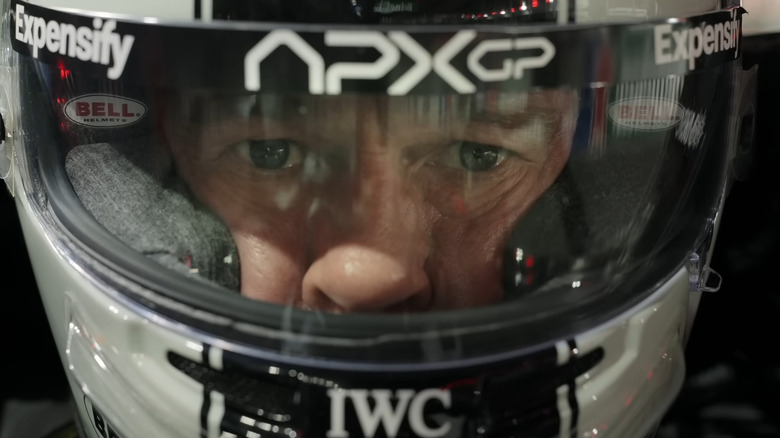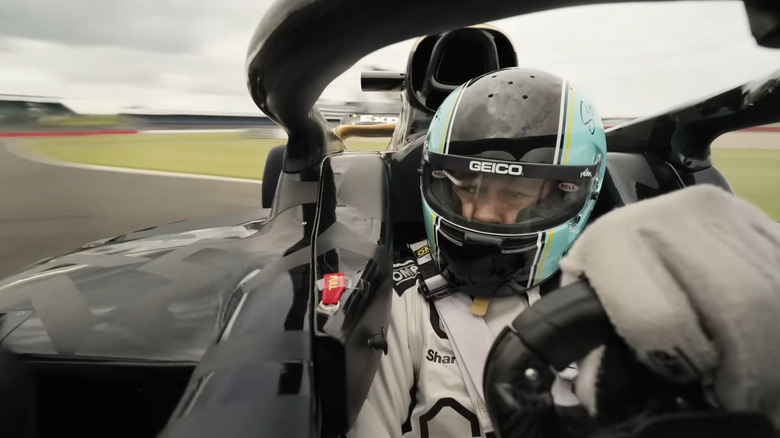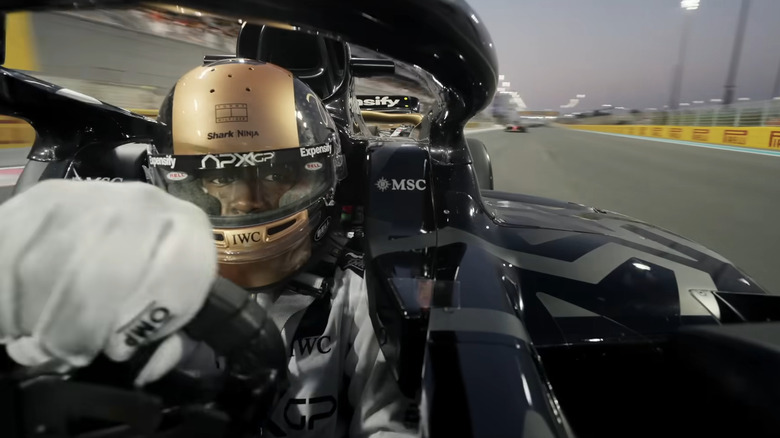Why F1's High Speed Racing Scenes Look So Realistic
Last summer, I had the pleasure of attending a unique screening of John Frankenheimer's "Grand Prix" at the Somerville Theatre. We were warned up front that the rare 35mm print we were about to see had succumbed to the elements over the past few decades, resulting in a magenta sheen over the entire film. You optimally want to see a movie in the best conditions, especially for a first time viewing. Any trepidation I had about its faded appearance was dashed within the first 10 minutes as I bore witness to the most visually spectacular racing sequences I'd ever seen. It was as if the print was holding on for dear life until it made it across the near 3 hour finish line, and by god, did it make an impression.
Nearly every car movie over the past six decades owes some sort of tribute to the groundbreaking 1966 racing melodrama on account of how it transformed the way filmmakers depicted high speed thrills. "Grand Prix" mounted 65mm Panavision cameras to various Formula race cars that could capture actors like James Garner from behind the wheel, as well as their surroundings, via remote control as they were moving at speeds over 100mph. It invited you to feel like you were really there in the car, which was a significant step up in a medium where rear projection was the way to go with driving scenes. It was a film fueled by innovation, one that would inspire films such as "Le Mans" and "Days of Thunder." The revolutionary spirit of "Grand Prix" is still alive and well in theaters right now with Joseph Kosinski's "F1® The Movie" (yes, that's its official title).
Just a few summers ago, Kosinski and movie star daredevil Tom Cruise defied the odds and pushed the limitations of aerial photography with the immersive ride that was "Top Gun: Maverick." Much like "Grand Prix," it placed audiences in the driver's seats of these metal death machines, with the actors actually inside the vehicles. Upon hearing that Kosinski would be helming a movie about Formula 1, it made me incredibly excited to see how he would impart his lessons from working tirelessly over making that film look as good as it does.
/Film's Witney Seibold found plenty of faults with "F1" in his review, mostly with Brad Pitt's characterization of Sonny Hayes, yet couldn't deny the sheer excitement of the racing sequences. Kosinski understands the appeal of sound barrier thrills you want out of a summer blockbuster. "F1" may not reach the emotional heights of "Maverick," but it similarly boasts a story about a middle-aged man recapturing the thrills of his glory days by returning behind the controls of a highly dangerous vehicle that can move at the speed of light. "F1," however is not entirely a vanity project for Pitt, as he's only as good as his co-star in Damson Idris, who plays the hotshot up-and-comer Joshua Pearce. Together, the two embark on a globe-trotting adventure (Silverstone, Monza, Las Vegas, Suzuka, Mexico City, Spa, Hungaroring and Abu Dhabi) to get their team, APXGP, out from under the bottom. The film undoubtedly stretches its runtime, but once these two are behind the wheel, it's off to the races. Kosinski believes in making sure the audience knows they're doing this for real, going so far as to make the racing scenes feel realistic by once again pushing forward with technical innovations to make it all possible.
The tech wasn't there yet, so Kosinski and Co. built it from the ground up
In the event this is your first exposure to Formula 1 racing, you very rarely get a glimpse of the actual drivers from within the cockpit during the broadcast. Similar to "Maverick," Kosinski and cinematographer Claudio Miranda wanted to bring a similar "in the seat" viewing experience that gave you a firsthand account of Pitt and Idris behind the wheel. Doing so would require a similar technique they employed in the "Top Gun" sequel, where they were able to place small Sony Venice Rialto cameras inside the cockpits of the F-18s.
Considering the Formula cars they were putting the actors in was a much tighter space, Kosinski knew he had to push the envelope and construct his "F1" vehicles from the ground up in order to make them the perfect machine (via ScreenCrush):
"We worked with the Mercedes-AMG Formula One team to build our race car, and as we're building it, we worked into the design 16 different mounting points for our cameras and special bays underneath the radiators to hold the batteries and the recorders and the receivers. So it was a custom-built race car designed for shooting this movie. We made six of them."
The Bespoke Sony 6K Cinema Camera is not only the smallest ever produced, but was able to withstand exceptionale G-forces. (via Y.M. Cinema Magazine). Akin to "Grand Prix," Kosinski was able to work with Panavision to create a camera that's able to capture so many flexible perspective shots of the drivers and their surroundings (via ScreenCrush):
"The pan shot is kind of like turning your head. It's a very natural way to take in the world. But what I liked about it was when you're looking at the nose of a car rocketing down a track and then you pay 180 degrees and you see Brad Pitt looking at you with his hands on the wheel, you realize that he truly is controlling this thing by himself. The typical Hollywood thing is to cut: A shot of the car driving down the street, cut to a closeup of the actor's face moving the wheel, then cut to another angle from outside the car. We've all seen enough movies to know that those things aren't connected, that it's really an actor driving on a tow truck being towed, and a shot of a stunt driver driving down the road."
Given the film's exorbitant budget, which is rumored to be in the vicinity of $300 million, it appears that Kosinski put the money to good use in order to further hone his craft. It's a lot like how James Cameron is putting a wealth of resources into his "Avatar" sequels. For as groundbreaking as all this equipment is, a large part of what makes "F1" so exciting is witnessing the actors operating the vehicles themselves.
Brad Pitt and Damson Idris trained in Formula cars for four months
The cast of "Maverick" went through a vigorous training program in order to be prepared for going up in the sky, so it stands to chance that the stars of "F1" would have to go through something similar in order to be ready for the track. Kosinski puts Pitt and Idris through a four month course in order to be prepared to shoot at actual Formula 1 circuits (via Top Gear):
"We shot all the races you see in the film for real and then using a little Hollywood magic, we weave it all together and make it feel like Sonny Hayes and Joshua Pearce are the 11th team on the grid racing alongside all these drivers."
Idris felt especially lucky to be able to shoot at 14 different Grand Prix events after all of that training (via Sharp Magazine):
"The beauty of it was that we got to go ahead of the Grand Prix. We'd train at the track, and then we'd have these 10-minute slots during the race weekend to get our shots with the crowd, with the mayhem of Formula One,"
Production came to a bit of a standstill when the 2023 SAG-AFTRA strike came into effect while the cast and crew were at that year's British Grand Prix. But rather than that causing a hamper, it was actually a blessing in disguise for Pitt, as it allowed him to practice driving for a whole other year (via GQ).
In an age where it seems easier to use visible CG to simulate danger, it speaks to Kosinski, Pitt and Idris, along with the entire crew of "F1," that they were all so committed to capturing as much in-camera thrills as humanly possible. Ballooning budgets is almost certainly an issue with a lot of Hollywood projects, but this was no ordinary film. "F1" was crafted from the ground up to bring audiences back to the high octane realism set into motion by "Grand Prix," while moving the medium forward so other filmmakers can build off of what they've done here. Whatever you end up thinking about the film itself, that's pretty special.
"F1® The Movie" is now playing in theaters nationwide.


